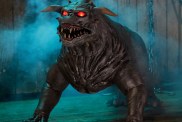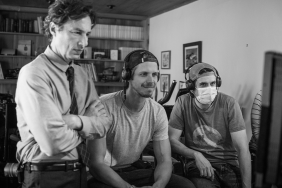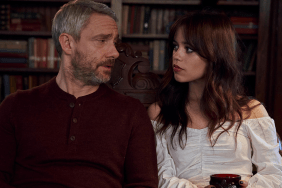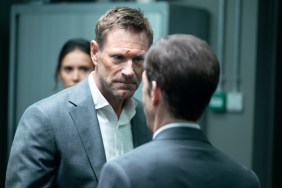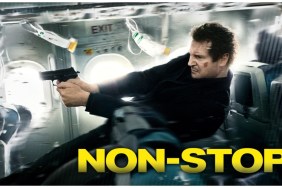Commercial helmer Jaume Collet-Serra cut his feature filmmaking teeth on the horror programmers House of Wax and Orphan, but he is slowly working his way into the big leagues with the help of our favorite Irish brawler, Liam Neeson.
Their first teaming on 2011’s Unknown proved so fruitful they’ve re-teamed for this week’s airline thriller/mystery Non-Stop, where Neeson plays an air marshal with a troubled past trying to save an intercontinental flight from terrorists. Later this year they’ll drop another actioner called Run All Night alongside RoboCop star Joel Kinnaman, so we can infer that Neeson is officially De Niro to Serra’s Scorsese.
We sat down with Collet-Sera to discuss smoking, not cutting to an exterior shot, his long-gestating live-action version of Akira and why the plot twist of Orphan didn’t work for this film?
ComingSoon.net: I have to say I’m a little disappointed that it didn’t turn out that the little girl was really a 30-year-old terrorist.
Collet-Serra: Yeah. We ran out of money for the visual effects. I wish we could have done that.
CS: (laughs) A part of me kept hoping her little bear was the bomb?
Collet-Serra: We thought about it! Not about that she was 30 years old, but that everything would revolve around the little girl somehow, and it became too cumbersome. Like what happened to her father? What plane was she supposed to take?
CS: She exists to be a surrogate daughter to Liam, the same way Newt was a surrogate daughter to Sigourney Weaver in “Aliens.”
Collet-Serra: Yeah, that’s what it is, that’s the original purpose, but then other ideas come out of desperation ’cause you’re trying to make things fresh. The purpose of the little girl was purely to see Liam as the father figure, something he cannot be anymore.
CS: Exactly. When we’re first introduced to Liam he was almost the stereotypical burnt-out cop, he’s got the cigarettes and the alcohol. The only thing missing was a lonely saxophone playing on the soundtrack. What’s cool is both the alcohol and the cigarettes wind up becoming crucial plot points, which is very clever.
Collet-Serra: Yes, in fact, I’m a smoker. As a smoker I feel the pressure of the world telling me not to smoke. So for me it was important to be like, “Hey, guess what? If the character doesn’t smoke everyone would be dead.”
CS: (laughs) That’s a great moral for the children.
Collet-Serra: No, but it’s true. Talking about stereotypes, and people judging on other people constantly, it’s perfect that it takes place on a plane. I mean I get stopped all the time. Look at me? I usually have a bigger beard. I’m usually in business class.
CS: You get profiled?
Collet-Serra: I get profiled all the time. In Germany I got stopped twice over 50 meters. That’s fine, but people get stereotyped all the time and you have to play with that. Smokers are also stereotyped. Everybody had their own little thing and that was Liam’s so I made it part of the plot.
CS: Is it true that the guy who runs Warner Bros. has a thing where he said no main characters in Warners movies will smoke?
Collet-Serra: Mmmhmm.

CS: Since you’ve made your last few movies at Warners, was the fact that this is Universal make you say, “Now I’m gonna get the smoker in there?”
Collet-Serra: No, because in “Orphan” Peter Sarsgaard smokes, in “Unknown” Bruno Ganz smokes and in fact has cancer, in “Run All Night” ?which I just shot- Liam smokes and Ed Harris smokes, and that’s Warner Bros. So it’s a suggestion. Warner Bros or any other studio who’s serious about making movies will never force a filmmaker over the use of product, because it’s movies, it’s not a commercial. They’ll suggest, “if you can minimize it then minimize it,” because there’s a social responsibility. I’m the first one who doesn’t want characters saying curse words gratuitously or to show blood gratuitously, but if it’s necessary for the movie you’re making then you show it. In “Non-Stop,” as you said, it’s essential.
CS: One of the things that was surprisingly absent was an exterior shot of the plane. You don’t really have a big exterior shot until the third act, then it’s only once. How important was it for you to keep everything contained within the fuselage?
Collet-Serra: For me it was the only way to go. I had to fight everybody else, ’cause it’s very unusual that they’ll allow you to do that because, rightfully so, they’re afraid as they read the script and watch dailies? “Is the audience going to get tired?” There were discussions of when he’s talking on the phone to see the other side, to see other characters and other people. At the end of the day common sense prevailed. It’s a movie that takes place in one set and that’s what it’s supposed to be.
CS: That gives it a kind of momentum because you’re stuck in this scenario with Liam. Without relief.
Collet-Serra: That’s because it’s a good movie in the sense that you have a good story you can follow and you have a good actor who can lead you there. I think only one out of ten movies like this would survive, meaning you’ve seen other movies in one plane–I don’t wanna mention names–and you want to be out of the plane, you want to get out. Potentially this could have been a problem. Thankfully, I think it wasn’t.
CS: Joel Silver is a great character and you’ve worked on a ton of movies with him. He refers to a movie like this as a commerce movie. Is that different from how you see it when you’re in the thick of making it?
Collet-Serra: No, that’s the movie I want to make. That’s what I did on “Unknown.” “Orphan” I wanted to make an elevated horror, elevated to psychological so it wouldn’t become another version of “Chucky.” Dealing with some sort of paranoia and human nature with the mom being overprotective of these kids. “Unknown” is a movie with a very simple concept, and so is this one. Movies with simple concepts are designed for the mainstream. You need to offer the concept then explore all possible angles on it. There’s not much you can do with them.
CS: Besides the intellectual exercise of that how do you dig in and find yourself as an artist and a filmmaker within a commerce movie like this?
Collet-Serra: I enjoy it. I enjoy the challenges. If you saw the script I got to make this movie, then you see the movie it ended up being you’ll see my artistry. That’s where I enjoy taking a concept which is very basic, completely flawed, and making it work. Making it entertaining so people can enjoy it. For me it’s an interesting process. This movie is a movie that should be seen by as many people as possible. The only purpose is to entertain, and I’m happy that’s the case.
CS: When you were working on “Akira”?
Collet-Serra: I’m still working on “Akira,” so that’s part of my life. (laughs)

CS: That’s great that you’re sticking with it despite the bumps in the road.
Collet-Serra: It’s great that they’re waiting for me. It’s different, because you have to be respectful of the source material. Otomo adapted his own work from a manga into an anime and both things are completely different and genius. The only way to do a live version of “Akira” is to take the spirit and adapt it. It will be as different as the anime was from the manga.
CS: What worries myself and a lot of the other fans of the property is you have elements that are commercial and sexy, like the motorbikes or the jaw-dropping futuristic backdrop, but for the most part it’s a very cerebral work. How do you maintain the essence of that without diluting it into essentially “Blade Runner: Mark 2”?
Collet-Serra: I think you cannot make a movie about “Akira” and hope that everyone understands it. Like everything else you have to make three or four movies in one where there’s the essence somewhere. If you’re a fan you already know what it’s about and you’ll see it’s part of the same world, but trying to oversimplify it would be a mistake. I think if at some point a character tries to explain it to the audience at the end of the second act that’s a problem. It’s more like an existential opera. It’s something that can only be explained in the manga, and even in the anime it’s hard to follow.
CS: And we all have that original anime, it’s there, nothing can sully it, so if you were going to do it in live-action one would hope you would bring something new to the table. What is it you are bringing specifically that is going to make it yours?
Collet-Serra: I hope that I can bring strong characters. In the original source material I don’t think the main characters are the protagonists. What I’m hoping is to bring characters.
CS: That’s true. It’s one of those strange stories where you literally never see the main character that is the namesake of the film!
Collet-Serra: Nobody’s interesting. Tetsuo’s interesting because weird sh*t happens to him, and Kaneda is so two-dimensional. That’s part of the Japanese culture, they never have strong characters. They’re used as a way to move the other philosophy forward.
CS: They’re ciphers.
Collet-Serra: Yeah. So hopefully in my version that will be strong, and you’ll have a story that happens in that world that will show you a little bit of the mystery. Then, if you’re interested, they’ll make “Akira 2 & 3” then you can get deeper into it. I love the world, a lot of people love that world, so why wouldn’t we indulge in it a little bit and see how it would be if it was real? Like you say I don’t have to explain everything, but wouldn’t you like to spend two-hours in a world of “Akira” and follow a character and be like, “that’s cool”? That’s all I want to offer, is two-hours in a world you can actually feel. We’re working on it.
Non-Stop opens the evening of Thursday, February 27.
(Photo source: Apega/WENN.com)
Non-Stop
-
Non Stop

-
Non Stop

-
Non Stop

-
Non Stop

-
Non Stop

-
Non Stop

-
Non Stop

-
Non Stop

-
Non Stop

-
Non Stop

-
Non Stop

-
Non Stop

-
Non Stop

-
Non Stop

-
Non Stop

-
Non Stop

-
Non Stop

-
Non Stop

-
Non Stop

-
Non Stop

-
Non Stop

-
Non Stop



